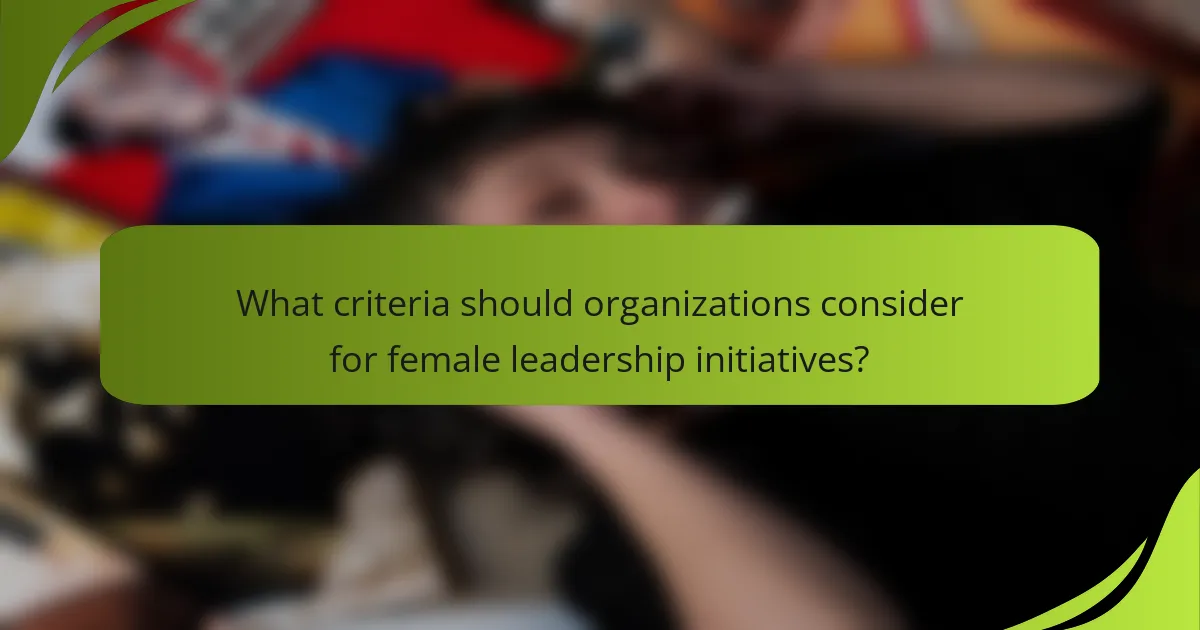Female leadership advocacy techniques are crucial for empowering women to assume leadership roles and influence key decision-making processes. By implementing targeted strategies that promote gender equity and inclusivity, organizations can create an environment where aspiring female leaders thrive. Effective methods include leveraging social media, sharing success stories, and fostering collaborations with male allies to enhance visibility and build supportive networks.

What are effective female leadership advocacy techniques?
Effective female leadership advocacy techniques involve strategies that empower women to take on leadership roles and influence decision-making processes. These techniques can enhance visibility, build networks, and provide essential skills for aspiring female leaders.
Mentorship programs
Mentorship programs connect experienced leaders with emerging female talent, fostering personal and professional growth. These relationships can provide guidance, support, and insights into navigating workplace challenges.
To implement a successful mentorship program, consider pairing mentors and mentees based on shared interests or career goals. Regular check-ins and structured goals can enhance the effectiveness of these partnerships.
Networking initiatives
Networking initiatives create opportunities for women to build connections within their industries. These events can range from informal meetups to formal conferences, allowing participants to share experiences and resources.
Effective networking involves not just attending events but also actively engaging with others. Follow up with contacts and seek opportunities to collaborate, which can lead to new career advancements.
Workshops and training sessions
Workshops and training sessions focus on developing specific skills necessary for leadership roles. Topics may include negotiation, public speaking, and conflict resolution, tailored to women’s unique challenges in the workplace.
To maximize impact, ensure these sessions are interactive and provide practical exercises. Consider offering them in various formats, such as in-person or online, to accommodate different schedules and preferences.
Public speaking opportunities
Public speaking opportunities allow women to showcase their expertise and build confidence. Engaging in speaking events can enhance visibility and establish credibility within their fields.
Encourage participation in local community events or industry conferences. Providing coaching or practice sessions can help women refine their speaking skills and overcome anxiety associated with public speaking.
Online platforms for advocacy
Online platforms serve as vital tools for female leadership advocacy, enabling women to share their stories and connect with a broader audience. Social media, blogs, and professional networks can amplify voices and promote leadership initiatives.
Utilize platforms like LinkedIn or Twitter to engage with other leaders and share insights. Consistent and authentic communication can help build a supportive online community that fosters female leadership development.

How can organizations support female leaders?
Organizations can support female leaders by implementing targeted strategies that promote gender equity and create an inclusive workplace culture. This involves establishing policies and practices that empower women to advance in leadership roles while ensuring they have the necessary resources and opportunities to succeed.
Diversity and inclusion policies
Diversity and inclusion policies are essential for fostering an equitable environment for female leaders. These policies should outline clear goals for representation, provide training on unconscious bias, and promote a culture that values diverse perspectives. Regular assessments can help organizations track progress and make necessary adjustments.
For effective implementation, organizations can establish diversity committees that include female leaders to guide policy development. Additionally, setting measurable targets for gender diversity at all levels can help maintain accountability and drive change.
Flexible work arrangements
Flexible work arrangements, such as remote work options and adjustable hours, can significantly benefit female leaders by accommodating their diverse responsibilities. These arrangements allow women to balance work and personal commitments, which is crucial for retaining talent and promoting career advancement.
Organizations should consider offering a variety of flexible options, including part-time roles, job sharing, and telecommuting. Clear communication about these options and their availability can encourage female leaders to take advantage of them without fear of stigma.
Leadership development programs
Leadership development programs tailored for women can enhance their skills and prepare them for higher roles within the organization. These programs should focus on mentorship, networking opportunities, and training in leadership competencies that are often underrepresented among female leaders.
Organizations can implement initiatives such as mentorship pairings with senior leaders, workshops on negotiation skills, and access to leadership conferences. Providing financial support for these programs can also demonstrate a commitment to developing female talent and encourage participation.

What strategies enhance female leadership visibility?
Strategies that enhance female leadership visibility include leveraging social media, showcasing success stories, and engaging in collaborative projects with male allies. These approaches not only promote awareness but also create supportive networks that empower women leaders.
Social media campaigns
Social media campaigns are a powerful tool for increasing visibility among female leaders. Platforms like LinkedIn, Twitter, and Instagram allow women to share their achievements, insights, and leadership experiences with a broader audience.
To maximize impact, campaigns should focus on authentic storytelling and engaging visuals. Using relevant hashtags can help reach target demographics, while regular posting keeps the audience engaged.
Highlighting success stories
Highlighting success stories of female leaders can inspire others and create role models within the community. This can be done through interviews, articles, or video features that showcase their journeys and accomplishments.
Consider organizing events or webinars where these leaders share their experiences. This not only elevates their profiles but also fosters a sense of community among aspiring female leaders.
Collaborative projects with male allies
Collaborative projects with male allies can significantly enhance the visibility of female leaders. By partnering with male colleagues, women can gain access to new networks and resources, amplifying their voices and initiatives.
When forming these collaborations, it’s essential to establish clear goals and mutual benefits. This ensures that both parties are invested in the success of the project, leading to more effective outcomes and increased visibility for female leadership.

What are the best practices for female leadership advocacy?
Best practices for female leadership advocacy involve strategic approaches that empower women in leadership roles. These practices focus on measurable goals, supportive communities, and regular feedback mechanisms to foster an inclusive environment.
Setting measurable goals
Establishing measurable goals is crucial for tracking progress in female leadership advocacy. Goals should be specific, achievable, and time-bound, such as increasing the percentage of women in leadership positions by a certain amount within a defined period.
Consider using the SMART criteria (Specific, Measurable, Achievable, Relevant, Time-bound) to formulate these objectives. For example, a company might aim to have 30% of its leadership roles filled by women within five years.
Creating supportive communities
Supportive communities play a vital role in female leadership advocacy by providing networking opportunities and mentorship. These communities can be formed within organizations or through external networks that focus on empowering women.
Encouraging participation in women-focused groups or forums can help build confidence and share valuable resources. Initiatives like mentorship programs or peer support groups can significantly enhance women’s leadership skills and visibility.
Regular feedback mechanisms
Implementing regular feedback mechanisms is essential for continuous improvement in female leadership advocacy. This can include performance reviews, surveys, or informal check-ins that allow women to express their experiences and challenges in leadership roles.
Feedback should be constructive and aimed at fostering growth. Organizations can benefit from establishing anonymous channels for feedback to ensure that all voices are heard and considered in decision-making processes.

What criteria should organizations consider for female leadership initiatives?
Organizations should focus on inclusivity, support structures, and measurable outcomes when developing female leadership initiatives. Key criteria include assessing current demographics, evaluating existing support systems, and establishing clear goals for advancement.
Assessment of current leadership demographics
Understanding the current leadership demographics is crucial for identifying gaps and opportunities for female representation. Organizations should analyze the percentage of women in leadership roles compared to their overall workforce and industry benchmarks.
Consider conducting surveys or utilizing HR data to gather insights on gender distribution at various levels of leadership. This assessment can highlight areas needing targeted initiatives, such as mentorship programs or leadership training specifically for women.
Evaluation of existing support systems
Evaluating existing support systems helps organizations determine how effectively they are fostering female leadership. This includes reviewing mentorship programs, networking opportunities, and policies that promote work-life balance.
Organizations should assess whether current support systems are accessible and effective for women. Gathering feedback from female employees can provide valuable insights into potential improvements, such as flexible working arrangements or targeted professional development resources.

How does female leadership advocacy impact organizational culture?
Female leadership advocacy significantly enhances organizational culture by promoting diversity, inclusion, and collaboration. This advocacy fosters an environment where diverse perspectives are valued, leading to improved decision-making and innovation.
Effectiveness of female leadership advocacy
The effectiveness of female leadership advocacy can be seen in various organizational outcomes, including employee satisfaction and retention rates. Companies that actively support female leaders often experience higher levels of engagement and productivity among their workforce.
Research indicates that organizations with gender-diverse leadership teams are more likely to outperform their peers in profitability and value creation. This correlation underscores the importance of advocating for female leadership as a strategic business imperative.
Strategies for advocating female leadership
To effectively advocate for female leadership, organizations can implement mentorship programs that connect aspiring female leaders with experienced mentors. These programs help build confidence and provide valuable networking opportunities.
Additionally, organizations should establish clear policies that promote gender equity in hiring, promotions, and pay. Regular training sessions on unconscious bias can also help create a more inclusive environment that supports female advancement.
Best practices for promoting female leaders
Best practices for promoting female leaders include setting measurable goals for gender diversity at all levels of the organization. Regularly reviewing progress against these goals ensures accountability and commitment to change.
Creating a supportive culture is crucial; this can be achieved through flexible work arrangements and family-friendly policies. Encouraging open dialogue about gender issues and celebrating female achievements within the organization can further reinforce a culture of support.


